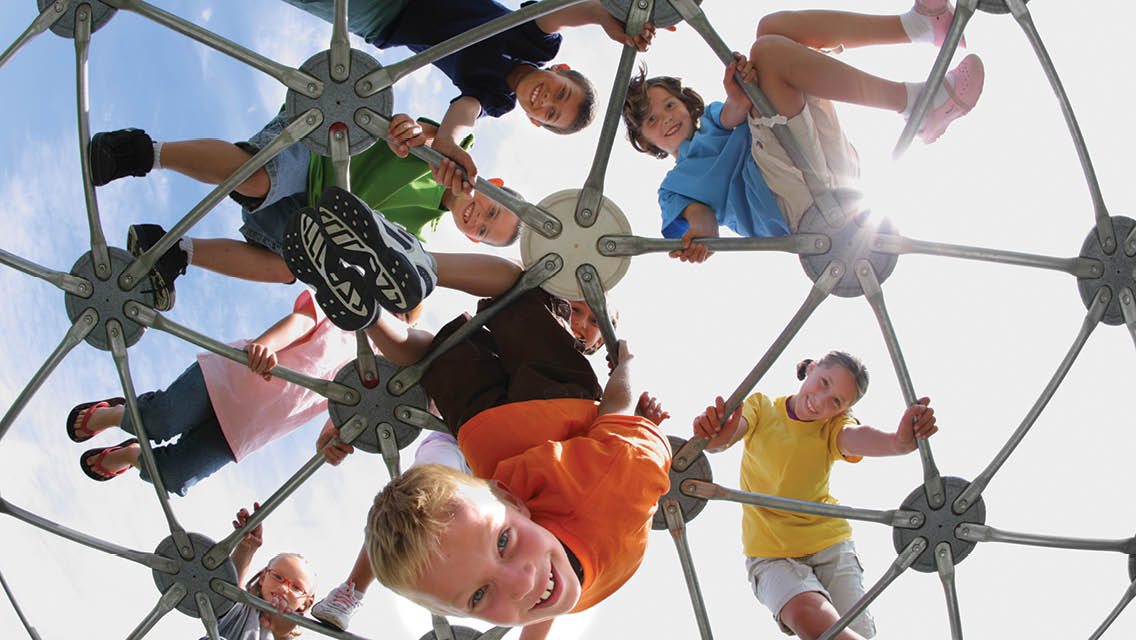Last fall my 14-year-old daughter, Kate, announced that she was going out for basketball. As an arts-loving eighth grader at a school better known for orchestra than athletics, she had no illusions of breaking into the big time of Southern California high school sports, where private coaches, performance psychologists, and year-round club teams are increasingly the norm. “My friends are all playing,” she reasoned.
A few weeks into the season, several of her friends abruptly quit the team — and Kate was starting to waver, too. “It’s so hard, and it takes so much time,” she said.
Her mom and I urged her to stick with it until the season opener — a six-team, all-day tournament that was two weeks away.
The night before the tournament, Kate wrote a pep-talk note to herself. “Reasons I should play basketball,” she titled it. Her No. 1 reason: “It will make Dad happy.”
The note gave me pause. My main hope was that she’d come to love vigorous movement — and maybe learn a few life lessons along the way. But was I pushing her too hard? Helping my kids navigate the thorny path of youth athletics, I could see that even my modest ambitions for them might be counterproductive.
An increasing emphasis on specialization from an early age, combined with school budget cuts that make physical education — the first introduction to exercise for many kids — optional or nonexistent, has largely divided kids into two camps. There are the all-in athletes, who devote their young lives to making it in their sports, and the activity averse, who often miss out on experiencing the joy of moving their bodies.
This is a cultural trend, says Mary Uran, cofounder of Girls on the Run Twin Cities, the Minnesota chapter of the national athletics-based life-skills program for girls. “By third grade, you’re either on track to do one sport year-round or you’re on the sidelines,” she explains.
Research backs this up: Athletic participation for kids ages 6 through 12 has dropped by 8 percent in the last decade, according to the Sports and Fitness Industry Association and the Aspen Institute. Another study found that the most common reason for quitting a team sport, among both boys and girls, is “not having fun.”
Among those who aren’t sitting out are kids who push themselves — or who are pushed — to be at the top of their game. The allure of college scholarships is strong when skyrocketing postsecondary education costs loom. Coupled with the dream of playing professionally, this focus on specialization has transformed youth sports into an annual $15 billion industry.
This is all unfortunate, I think. When I was young, there was room for both superstars and slackers on our teams. After games, we all high-fived, went home, did our homework. In this new climate, I wonder, is it possible for active-but-not-superstar kids to find the middle between sports obsessed and sports averse?
The experts say yes. Like everything else in parenting, it just takes time and attention.
Guiding the All-In Athlete
“Youth athletics is becoming an industry,” says sports psychologist Dan Saferstein, PhD, author of Win or Lose: A Guide to Sports Parenting.
“There are parents spending over $50,000 a year on coaching and training for their kids,” he explains. Name your sport, and across the country you’ll find young athletes rising for predawn practices, staying after school for extra coaching, and spending weekends in elite facilities, hoping for an edge in the fierce competition for spots on club teams, scholarships, or Olympic glory.
“It can be great to be into sports,” Saferstein admits. “And, of course, some kids are truly elite.” Like the gifted math whiz or music virtuoso, the gifted youth athlete thrives in what others perceive as an overly pressurized situation; such children discover a chance to belong, express themselves, and excel.
The situation can easily turn problematic, however. “Parents call me when their kids aren’t performing at their potential, when they’re getting stomachaches, when they want to quit,” he notes.
It’s possible for parents — together with coaches and teachers — to nurture young athletes’ desire to achieve while helping them maintain a sense of balance, Saferstein adds. Fundamentally, it’s about perspective: helping child athletes appreciate and enjoy sports without letting them become overwhelmed.
Consider these four strategies.
1. Manage expectations.
“So many parents — myself included, for a few years — get this notion that their kids have talents that should be nurtured to the highest degree,” says Ruth Marsh, who raised a former Washington youth-gymnastics champion. “In the moment, it all feels important; maybe your kid will miss out if she or he doesn’t get all the training.”
Despite all the praise that skilled children receive, only a fraction of talented kids ever make the Olympic team or play in the pros, regardless of training and commitment. Of the nearly 8 million U.S. students who participate in high school athletics, a mere 6 percent eventually compete as National Collegiate Athletic Association (NCAA) athletes.
An even tinier percentage move up to the professional or Olympic level. Less than 1 percent of high school athletes receive athletic scholarships, and only 0.03 to 0.05 percent go on to play professionally, according to the NCAA.
“At some point, most kids have to re-sketch their dreams,” says Saferstein. For some, that might mean going to a Division III college instead of a DI school.
For others, it might mean accepting that high school may be the end of the line for that sport and instead embracing the idea of carrying the lessons they learned with them through life: They can continue to strength train, for example, and they will certainly use their skills in teamwork and collaboration.
“In different stages of your life,” he says, “you have to make peace with what’s gone your way and what hasn’t. You have to learn to be disappointed without being disappointed in yourself.”
2. Avoid specialization.
Many kids these days focus on playing just one sport, often year-round, in hopes of making an elite team. In reality, though, this is less likely to lead to athletic stardom and more likely to set a child up for injury.
The “increased emphasis on sports specialization has led to an increase in overuse injuries, overtraining, and burnout,” according to a 2016 report from the American Academy of Pediatrics. An estimated 50 percent of athletic injuries among youth ages 18 and younger are related to overtraining.
A 2017 study published in the American Journal of Sports Medicine found that among the 1,500 boys and girls surveyed, those who had higher levels of specialization were 50 percent more likely to be injured.
Experts agree that playing multiple sports is good for the body and mind. Variation in physical stressors builds general fitness for health and longevity, while focusing on one activity can lead to overtraining and repetitive injuries with long-lasting repercussions. Mixing things up with more casual pursuits can also help relieve the pressure to be the best at just one thing.
And avoiding specialization doesn’t have to hinder progress in a favorite activity; in fact, many pro athletes come from a multisport background.
Cross-training and active recovery, especially during the off-season, are key for adult athletes — and kids can benefit from these practices as well. If a child loves basketball but also enjoys Rollerblading, it’s a good idea to mix in some wheel time for the fun of it.
3. Change your mindset.
To some, sport is the ultimate zero-sum activity: One player wins only if another loses. For athletic kids, who can be borderline obsessive about how they stack up against others, the winner-or-loser definition of success can be addictive. (The first thing my son Dylan tells me after school is how he fared in his pickup basketball game at recess.) So some amount of comparison is unavoidable.
That’s why it’s essential to instill and model a mastery mindset early. Striving for mastery instead of victory is a form of intrinsic motivation, Uran explains. Inspiration arises from the activity itself rather than from a desire to beat other people. As the old saying goes, it doesn’t matter whether you win or lose; it’s how you play the game. “The focus is on setting personal goals and then achieving them, not measuring yourself against others,” she says. “Your main competition is against yourself.”
It’s love of the game rather than love of conquest.
Parents can help encourage kids to take this broader view of success by emphasizing personal victories. For some athletes, a one-mile run is a major accomplishment and can be acknowledged as such, regardless of how the child places in the race. For others, completing a sub-19-minute 5K is an attainable goal — and something parents can support and applaud.
After a game, instead of asking your child, “Did you win?” ask her if she had fun, or if she was happy with how she played. You can also foster a mastery mindset in your child by calling attention to rebounds, aggressive play on defense, leadership, hustle, and improvement.
4. Lead by example.
In many martial-arts traditions, an advanced student often serves as senpai — a mentor — to a newer one during class. Although this takes time away from senior students’ workouts, it’s considered an essential part of their learning. On many sports teams, captains and assistant captains also serve as mentors.
Parents and coaches alike can encourage their more-skilled athletes to adopt these types of big-brother and big-sister roles, supporting younger kids and taking less-experienced teammates under their wings.
Often this checks the ego of the better athletes and helps them look outside themselves, which is essential in team sports and in life.
“We had this really fast girl in the Girls on the Run program once,” Uran recalls. “And she ignored all our lessons about being noncompetitive. One day she fell during a run and scraped her leg, and another girl stopped her workout to help her. She offered to walk a lap with her.”
It was a small gesture, but it changed the girl, says Uran. “She saw that this other girl cared about her, and not just because she was fast, but because she was a fellow runner.”
After that, Uran notes, “she still ran ahead of everyone,” but she began encouraging others and running alongside the slower kids after her own workout was done.
“She saw what being on a team was really all about.”
Encouraging Activity-Averse Kids
Not every child is innately athletic, and the competitiveness of today’s youth sports can discourage middle-of-the-pack kids who, a couple of generations ago, would have made up the backbone of most school or Little League teams. This often leaves kids of average ability feeling there’s no place for them in sports — and, later in life, no place for them in the gym, yoga studio, or on the biking trail, either.
Girls are particularly prone to opting out. “By the time kids are 8 years old, there’s already a huge dichotomy between boys and girls in terms of activity,” says Uran. “That plays into problems with obesity, depression, and other risk factors later in life.”
Adding to this is the increasing presence of screen activities — watching TV, engaging with social media, and playing video games — which are associated with a higher obesity risk. “We’ve had kids in Girls on the Run who get no physical activity at all,” says Uran.
Long-term excessive screen time poses serious health risks. Children who watch three hours or more of TV daily are 65 percent more likely to become obese than those who watch less than an hour, according to an Active Living Research report.
For parents and children who tend to steer clear of sports and physical endeavors, experts offer the following guidance.
1. Model an active life.
Want active kids? Get active yourself. For every 20 minutes of daily physical activity performed by a parent, Canadian researchers found, a child’s activity level rose by five to 10 minutes.
Modeling an active lifestyle may be one of the more powerful steps you can take in ensuring that your child enjoys activity and stays active for life, explains Jim Thompson, founder and CEO of the Positive Coaching Alliance.
“Your kids can be successful without sports,” he says. “But if you’re someone who shares your enthusiasm for exercise with your kids, they’ll get excited about it, too.”
For kids under 10, Thompson suggests sticking with noncompetitive activities. “Walk the dog with them. Toss a ball back and forth and count how many throws and catches you can get before a drop.” Instead of competing, work together to get better.
“Keep it positive,” he says, “and stay away from anything that suggests that their performance in competition determines how much you care about them.”
2. Find a different groove.
How we’ve traditionally defined “sport” in the United States has -limited our understanding of what it means to be active. Although organized, competitive team sports can be wonderful, they’re not suited to all children.
Experts encourage adults to expand their own views about what it means to be active and guide their children to explore hobbies that get their bodies moving. Yoga, walking, running, and cycling are great for kids who have more solitary dispositions — these activities can also be done as part of clubs, but they don’t have to be competitive.
There is an almost endless array of dance options open to beginners and kids of all ages: Ballet, tap, swing, contra, and Bollywood are just a few. Less-conventional activities, such as Ultimate Frisbee, circus arts, and even youth powerlifting, might also intrigue your child.
Unsure what activity to push your kid toward? Try asking instead of pushing. Find out what he or she enjoys and wants to master, and let that guide you.
3. Choose your words.
Kids are sponges: The demeanor, actions, and words of the adults around them affect kids deeply, and they can sniff out insincerity a mile off. For more than 20 years, Thompson has been studying the best ways to communicate with young athletes. His conclusion? It’s not about buttering them up. “Feedback needs to be truthful and specific,” he says. “You can’t tell a kid he’s trying really hard if he’s screwing around.”
In difficult moments, a better technique is what Thompson calls the “You’re the kind of person . . . ” approach: “When a kid seems discouraged, it’s OK to acknowledge it,” he says. “But follow that up. You might say, ‘What I like about you is that you don’t stay disappointed. You come to the next practice ready to play and get better.’ Or ‘You’re the kind of person who doesn’t give up easily,’ or ‘You seem to enjoy trying hard, whether you win or lose.’”
Look carefully enough, he says, and you can find something exemplary in every kid’s behavior on a team. Maybe it’s supporting a teammate who’s upset or injured. Maybe it’s coming to practice with a smile. Maybe it’s cheering while waiting for a turn at bat.
“Part of the job of a parent is to be a noticer,” he explains. “And to acknowledge and praise the little things that the kid is doing well.” He calls this “filling the emotional tank,” and it’s an effective and powerful practice for fostering growth both on and off the field.
4. Encourage active play.
“Culturally, in the mainstream, we’ve promoted sports as the best path to staying active,” says José González, a founder of Latino Outdoors, a program that promotes healthy outside activities for Latino kids and their families. This works perfectly for kids who thrive on goals and structure.
For other kids, sports can feel like work — but that doesn’t mean they’re lazy or inactive by nature. They may just crave a different approach.
“We too often devalue play — we say, ‘Quit playing around!’ like it’s something bad,” says González. “But at Latino Outdoors, we encourage the idea that nature should be a place to play and explore. So, they play tag, play hide-and-seek, climb trees, run.”
Competitive sports can be Darwinian at times: Regardless of how positive the atmosphere and supportive the coaching, kids can still get the impression that the strong survive and the weak get weeded out. Outdoor play is more forgiving. Public outdoor spaces are becoming increasingly accessible, and organizations like Latino Outdoors and Girls on the Run are helping kids of all shapes, sizes, ages, fitness levels, and cognitive abilities reclaim their right to move — and enjoy movement — together.
The lesson: In nature, there’s a place for everyone.
Conclusion
The morning of my daughter’s basketball tournament, I was still thinking about the pep-talk note, wondering if I’d overstepped boundaries, while Kate was nervous to the point of nausea. But as the tournament began, I saw her confidence build. Her shots became less tentative, her defensive play more assured. She set picks, pulled down rebounds, and hustled around the court. She smiled, laughed, high-fived her teammates.
A few games into the season, she hit her first basket — then her second and third. Practice remained tough, but she enjoyed games, made good friends, worked up a sweat, and experienced herself as strong and physically competent. She learned to share the spotlight and work together with others in pursuit of a goal.
I couldn’t have asked for more.
This originally appeared as “Playing for the Future” in the September 2018 print issue of Experience Life.





This Post Has One Comment
Whatever the exercise, sport or fitness system that ones uses, staying fit is a function of working on a regimen and staying true to it for large swathes of time. You can practice in large groups, small groups, as an individual or with a friend or two. All it takes is fair resolve and commitment. Stay fit, stay happy.